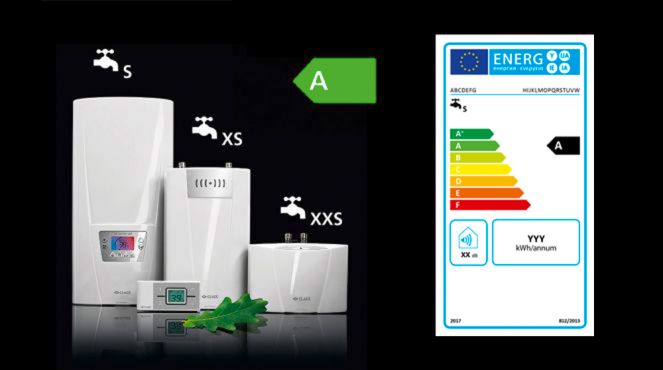
The energy label is coming – an »A« for instant water heaters
The energy label scheme regulates the efficiency labelling of energy related products (ErP) in Europe. This type of labelling is already familiar on household appliances like refrigerators and televisions. As of 26 September 2015 it will be compulsory for water heaters as well. From that date all manufacturers are required to label their products with a standardised energy label. The new labels contain various information about the appliance and are intended to assist consumers in making an environmentally conscious purchase decision.In a comparison of different water heating systems, on-demand instantaneous heaters were classed as A, which is the best energy efficiency class. The reason is that, unlike storage systems, instantaneous water heaters only consume energy when hot water is actually drawn off. No energy is used keeping water hot in a storage tank.
The energy efficiency class is not the only criterion, however. The detailed information on the label also needs to be considered, as there are huge differences in energy consumption within an efficiency class. That's why it's important to interpret all the information on the energy label correctly and take it into account when making a buying decision. The individual parts of the energy label are explained below.
Tap profile
When deciding on an appliance, the first thing to consider is the application. This is visualised by the tap profile. For example, a water flow of 2 litres per minute is perfectly sufficient for a hand basin. In this case a mini instantaneous water heater with the small XXS tap profile is the right choice. Supplying a kitchen sink needs an appliance with the next-largest tap profile, XS, for instance a compact instantaneous water heater delivering 5 litres of hot water per minute. To supply several taps in the bathroom or within a flat, a large instantaneous water heater with a mixed water flow rate of 10 to 15 litres per minute is needed. These appliances have an S tap profile. Large tanks that can supply several flats have correspondingly larger tap profiles, from L to XXL. But it is not energy efficient to keep a lot of water hot all the time when only a small quantity of water is needed. That's why it's important to choose the most suitable water heater for the particular requirement.
Energy efficiency class
The new energy efficiency label uses the familiar coloured bar system of labelling used on domestic appliances. In this case too, the seven efficiency classes are graded according to the traffic light system, with a green bar denoting the highest efficiency class, A, and a red bar representing the lowest efficiency class, G. The black arrow positioned next to one of the coloured bars indicates the efficiency class of the particular appliance.
Noise level
Another criterion to consider when buying an appliance is the noise level. A sound level of about 25 decibels (dB) can be perceived by the human ear in a very quiet room. A normal conversation at a distance of one metre registers around 50 dB. As instantaneous water heaters produce only a negligible sound level (15 dB), their noise level can be disregarded. In the case of pumped systems (e.g. heat pumps), on the other hand, this value is a significant purchasing criterion.
Energy consumption
Even more important than the efficiency class is looking at the annual energy consumption. Electronic and hydraulic instantaneous water heaters are both expected to qualify as the very good efficiency class A. In reality, though, an electronic instantaneous water heater saves up to 30% energy compared with a hydraulic model as it automatically adjusts the power draw and, thus, the energy consumption to the hot water demand and temperature. So it's worthwhile looking closely at the different appliances' energy consumption and comparing the values.
Using off-peak electricity
Homes and industry use less electricity at night than during the day. Off-peak electricity tariffs were introduced in the seventies to even out capacity utilisation at power stations. In the last few years, however, customers have had to cope with huge price increases and the gap compared with the ‘normal’ tariff narrowed a long time ago. The clock symbol on the energy label indicates whether the appliance concerned can be used on an off-peak tariff.
Conclusion
The new energy labels for water heaters show that using on-demand instantaneous water heaters is currently the most energy-efficient hot water technology. When it comes to selecting the most suitable appliance, though, the energy efficiency class A on its own is not very meaningful. It's very important for the customer to look at the tap profile and the annual energy consumption in order to make the right choice.
